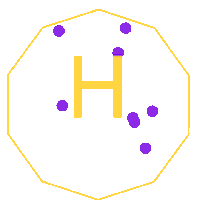What is Hydrogen?
Atomic mass: 1.0078 u

Basic Properties
- Atomic Number: 1
- Atomic Weight: 1.008
- Element Category: Nonmetal
- Phase at Room Temperature: Gas
- Electron Configuration: 1s¹
Physical Characteristics
- Colorless, odorless, and tasteless gas at room temperature.
- Has the lowest density of all gases.
- Exists primarily as diatomic molecules (H2) under normal conditions.
- Highly combustible and burns with a pale blue, almost invisible flame.
Occurrence and Production
- Most of the hydrogen on Earth exists in water molecules(H 2O ) , hydrocarbons (like petroleum), and other organic matter.
- Industrially, hydrogen gas is produced primarily by steam reforming of natural gas where high temperatures are used to split hydrocarbons into hydrogen and carbon dioxide. Other methods include:
- Electrolysis of water: Splitting water into oxygen and hydrogen using electricity.
- Thermal processes, such as partial oxidation and coal gasification.
- Biological processes, through the action of microorganisms on organic substrates.
Uses
- Energy Carrier: Hydrogen is seen as a significant future energy carrier, particularly in the context of hydrogen fuel cells, which convert the chemical energy of hydrogen to electricity, with water as the only byproduct.
- Industrial Applications: Used in the Haber process to manufacture ammonia ( N H 3 ) , which is a building block for the production of fertilizers.
- Petroleum Refining: Used to remove sulfur from fuels in the refining process.
- Food Industry: Hydrogen is used as a food additive (E number E949) to help maintain food texture and moisture.
- Scientific Research: Used in a variety of research applications, including the study of quantum mechanics and energy research.
Isotopes
- Hydrogen has three naturally occurring isotopes:
- Protium : Has no neutrons and is the most common isotope.
- Deuterium : Contains one neutron. It is used in nuclear fusion experiments and other applications due to its greater stability compared to protium.
- Tritium : Contains two neutrons and is radioactive. Tritium is used in research, and in devices like self-luminous aircraft exit signs and watches.
Environmental and Safety Aspects
- Non-toxic, but can be a breathing hazard at high concentrations due to oxygen displacement.
- Highly flammable and requires careful handling and storage.
- Considered a clean fuel as its combustion only produces water; however, its production can be environmentally intensive, depending on the method used.
Future Prospects
- Hydrogen is viewed as a potential solution for clean energy, especially if methods of producing it from water using renewable energy become more economically viable.
- Hydrogen fuel cells are being developed for use in vehicles, stationary power, and portable applications, potentially reducing dependence on fossil fuels.
What is the atomic number of hydrogen?
- Answer: The atomic number is 1.
What is the most common isotope of hydrogen?
- Answer: The most common isotope is Protium, which has no neutrons.
What type of bond does hydrogen commonly form?
- Answer: commonly forms covalent bonds.
What is the symbol for hydrogen?
- Answer: The symbol is H.
Is hydrogen a metal or a non-metal?
- Answer: Non-metal.
In what state does hydrogen naturally occur at room temperature?
- Answer: Naturally occurs as a gas at room temperature.
What is the standard atomic weight of hydrogen?
- Answer: The standard atomic weight is approximately 1.008 u.
How is hydrogen used in the universe formation?
- Answer: Crucial in the formation of stars and galaxies through nuclear fusion.
Can hydrogen exist in liquid form? Under what conditions?
- Answer: Yes, it can exist in liquid form under very low temperatures and high pressure.
What is the primary use of hydrogen in industries?
- Answer: The primary industrial use is in the production of ammonia for fertilizers through the Haber process.
What is a unique property of hydrogen regarding its electron configuration?
- Answer: Single electron in its outer shell, which makes it highly reactive and able to bond with a variety of elements.
How is hydrogen involved in energy production?
- Answer: Used in fuel cells to produce electricity by reacting with oxygen to form water.
What are the environmental impacts of using hydrogen as a fuel?
- Answer: Produces no direct emissions of pollutants or greenhouse gases, making it an environmentally friendly energy source.
Where is hydrogen most abundantly found in nature?
- Answer: Most abundantly found in water (H2O).
What was the role of hydrogen in the discovery of the electron?
- Answer: Hydrogen’s emission spectrum was instrumental in the development of the Bohr model of the atom, leading to insights into electron arrangements.
Who discovered hydrogen and in what year?
- Answer: First recognized as a distinct substance by Henry Cavendish in 1766.
What is the boiling point of hydrogen?
- Answer: The boiling point is -252.87°C.
Why is hydrogen considered a potential future fuel?
- Answer: it is considered a potential future fuel because it can be produced from various sources and its use results in water vapor, which is harmless to the environment.
How is hydrogen stored and transported?
- Answer: It is stored and transported in compressed or liquefied form in tanks under high pressure.
What is the role of hydrogen in the human body?
- Answer: It plays a critical role in the human body primarily through its presence in water, which is essential for all known forms of life.
Where is hydrogen found?
- Answer: It is found primarily in water (H2O) on Earth, making up about two-thirds of the mass of the human body and covering about 71% of the Earth’s surface in the form of oceans, rivers, and lakes. It is also found in all organic compounds and available in the atmosphere in trace amounts as a gas.
Is hydrogen H2 or H2O?
- Answer: Itself is denoted as H2 when it is in its diatomic molecular form as a gas. H2O, on the other hand, represents water, a compound consisting of two hydrogen atoms bonded to one oxygen atom.
Is hydrogen a gas or a fuel?
- Answer: It is a gas at standard temperature and pressure. However, it can also be considered a fuel when used in energy production processes, such as in hydrogen fuel cells where it is used to produce electricity.
How is hydrogen used for energy?
- Answer: It is used as an energy source primarily in fuel cells and hydrogen-powered combustion engines. In fuel cells, hydrogen reacts with oxygen to produce electricity, water, and heat in a clean process that emits no pollutants. This makes it an attractive option for powering vehicles and generating electricity in stationary power plants.
- Fuel Cells:
- Hydrogen Fuel Cells: Hydrogen is used in fuel cells to produce electricity through a chemical reaction between hydrogen and oxygen, emitting only water as a byproduct. This is utilized in vehicles, backup power systems, and portable power devices.
- Ammonia Production:
- Haber Process: Hydrogen is combined with nitrogen to produce ammonia (NH₃), which is a key ingredient in fertilizers. This process is critical for agricultural productivity.
- Refining Petroleum:
- Hydrocracking and Desulfurization: Hydrogen is used in the refining process to break down larger hydrocarbon molecules into gasoline, diesel, and other valuable products. It’s also used to remove sulfur from fuels, which reduces sulfur dioxide emissions when the fuel is burned.
- Hydrogenation of Fats and Oils:
- Food Industry: Hydrogen is used to convert unsaturated fats and oils into saturated fats, which changes the texture and shelf life of food products such as margarine and shortening.
- Coolant in Power Generators:
- Electrical Generators: Hydrogen’s high thermal conductivity makes it an excellent coolant for electrical generators in power plants, where it helps to dissipate heat efficiently and maintain optimal operating temperatures.
- Other Applications:
- Space Exploration: Hydrogen is used as a rocket propellant, particularly in the form of liquid hydrogen, due to its high energy content.
- Metal Production: Used in reducing metallic ores to pure metals.
- Welding and Cutting: Hydrogen flames are used in oxy-hydrogen torches for welding and cutting metals.
- Chemical Industry: Used in various chemical reactions as a reducing agent or reactant in the production of methanol, hydrochloric acid, and other chemicals.






